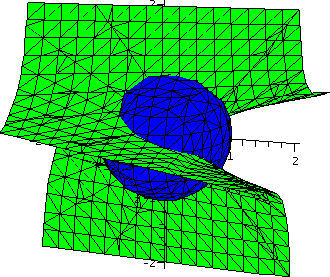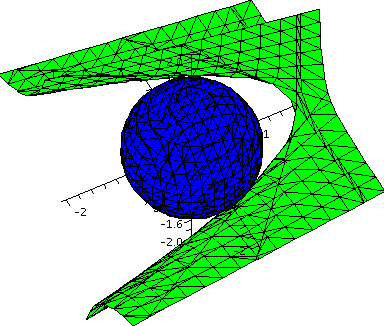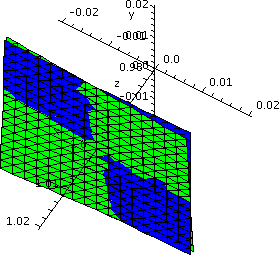Lagrange multiplier comment
The grading guidelines for problem 1 state that there will be
6 points for the correct analysis of these equations. The analysis
must include discussion of the case y=0 and z=0, and this is worth 2
of the 6 points.
and perhaps some people might object. Here is the situation, in more
detail than you might like, but with enough information to confirm the
importance of finding all solutions to the Lagrange multiplier
equations.
The constraint in this problem is
x2+y2+z2=1, a sphere. That's easy to
understand and to visualize. The objective functions in the two
versions of the exam are x+3yz and x+5yz. If k>0, then the points
satisfying z+kyz=constant form a graph which is a hyperboloid with
one sheet, sort of a nice surface.
Studying x+3yz on x2+y2+z2=1
We will consider x+3yz and what happens on the unit sphere. Similar
things happen for x+kyz where k is any number larger than 1.
To the right is a picture of x+3yz=.5
and x2+y2+z2=1.
The .5 is really just a random value, and the surface divides the
sphere into two pieces. In one piece, the function x+3yz has values
bigger than .5, and in the other piece, the values of the function are
less than .5. We would like to find maximum and minimum values of the
function on the sphere.
|  |
|
Now look at x+3yz=Constant.
There are four values of the constant for which the
hyperboloids are tangent to the sphere, and these are the values which
are detected by the Lagrange multiplier method.
For +5/3 and -5/3, the surfaces sit outside the sphere, and these
constants represent the extreme values of the objective function on
the sphere. These are relatively easy to understand, and a picture of
x2+y2+z2=1
and x+3yz=5/3 is shown to the
right. There are two points where these surfaces touch each other, and
they have the same tangent plane at these two points. The points are
(1/3,2/3,2/3) and (1/3,-2/3,-2/3), and 5/3 is the maximum value
of the function on the sphere.
|  |
|
Besides 5/3 and -5/3, the Lagrange multiplier equations have
solutions for two other values of the Constant. These are +1 (the point
(1,0,0) has this value for x+3yz) and -1 (the point (-1,0,0) has this
value for x+3yz). The related surfaces are indeed also tangent
to the sphere, but these values are saddles for the objective function
on the sphere. If you "look" near the points of tangency (and there
will be only one tangent point in each case, unlike the 5/3 or -5/3
cases where the surfaces are tangent at two points) there are points
nearby on the sphere which have values of the objective function
greater than 1 and points nearby which have values of the objective
function less than 1. This can actually be seen by asking Maple graph the unit sphere and x+yz=1
together (two implicitplot3d
commands). You will need to make the picture quite close to (1,0,0) in
order to see this effect.
|
To the right is a picture of x2+y2+z2=1
and x+3yz=1 in this window:
-.98≤x≤1.02, -.2≤y≤.2, and -.2≤z≤.2. This is a
rather tiny window, and both surfaces seem almost to be planes. I used
a tiny window because the picture is even less clear on a bigger
scale! The two surfaces are tangent to one another but they pass
through each other. Really the green and blue should all meet at one
point, the point (1,0,0), but the arithmetic is close and the graphing
software not so precise. The most analogous picture from calc 1 is how
y=x3 and y=0 are related near (0,0). These other solutions
of the multiplier equation represent something real.
| 
|
Studying x+.5yz on x2+y2+z2=1
 You may object that +/-1 are not the max and min, and ask why there
should be a penalty for ignoring them? But they may indeed be the max
and min values. If you consider x+kxy with the same constraint,
x2+y2+z2=1, when 0<k<1,
then the values +1 and -1 which could easily be ignored initially
are the actual max and min values and the two points where the
extreme values occur are the points (1,0,0) and (-1,0,0). In this
case, these are the only solutions to the multiplier equations,
and these solutions, which some people might ignore (hey, these
solutions must be "trivial" because things are 0), give the max and
min values. To the right is a picture of x2+y2+z2=1
and x+.5yz=1. 1 is the maximum value
and the surfaces are tangent to each other at only one point. The
geometry is different from the previous case.
You may object that +/-1 are not the max and min, and ask why there
should be a penalty for ignoring them? But they may indeed be the max
and min values. If you consider x+kxy with the same constraint,
x2+y2+z2=1, when 0<k<1,
then the values +1 and -1 which could easily be ignored initially
are the actual max and min values and the two points where the
extreme values occur are the points (1,0,0) and (-1,0,0). In this
case, these are the only solutions to the multiplier equations,
and these solutions, which some people might ignore (hey, these
solutions must be "trivial" because things are 0), give the max and
min values. To the right is a picture of x2+y2+z2=1
and x+.5yz=1. 1 is the maximum value
and the surfaces are tangent to each other at only one point. The
geometry is different from the previous case.
These pictures were created using implicitplot3d in Maple.
Conclusion?
That's why I reserved 2 points in the analysis for the solutions that
seem to be silly. You can't ignore any of the solutions to the
multiplier equations, because they might actually represent the max
and the min. I hope the discussion and pictures helped you understand
a complicated situation.
Maintained by
greenfie@math.rutgers.edu and last modified 11/21/2008.



 You may object that +/-1 are not the max and min, and ask why there
should be a penalty for ignoring them? But they may indeed be the max
and min values. If you consider x+kxy with the same constraint,
x2+y2+z2=1, when 0<k<1,
then the values +1 and -1 which could easily be ignored initially
are the actual max and min values and the two points where the
extreme values occur are the points (1,0,0) and (-1,0,0). In this
case, these are the only solutions to the multiplier equations,
and these solutions, which some people might ignore (hey, these
solutions must be "trivial" because things are 0), give the max and
min values. To the right is a picture of x2+y2+z2=1
and x+.5yz=1. 1 is the maximum value
and the surfaces are tangent to each other at only one point. The
geometry is different from the previous case.
You may object that +/-1 are not the max and min, and ask why there
should be a penalty for ignoring them? But they may indeed be the max
and min values. If you consider x+kxy with the same constraint,
x2+y2+z2=1, when 0<k<1,
then the values +1 and -1 which could easily be ignored initially
are the actual max and min values and the two points where the
extreme values occur are the points (1,0,0) and (-1,0,0). In this
case, these are the only solutions to the multiplier equations,
and these solutions, which some people might ignore (hey, these
solutions must be "trivial" because things are 0), give the max and
min values. To the right is a picture of x2+y2+z2=1
and x+.5yz=1. 1 is the maximum value
and the surfaces are tangent to each other at only one point. The
geometry is different from the previous case.